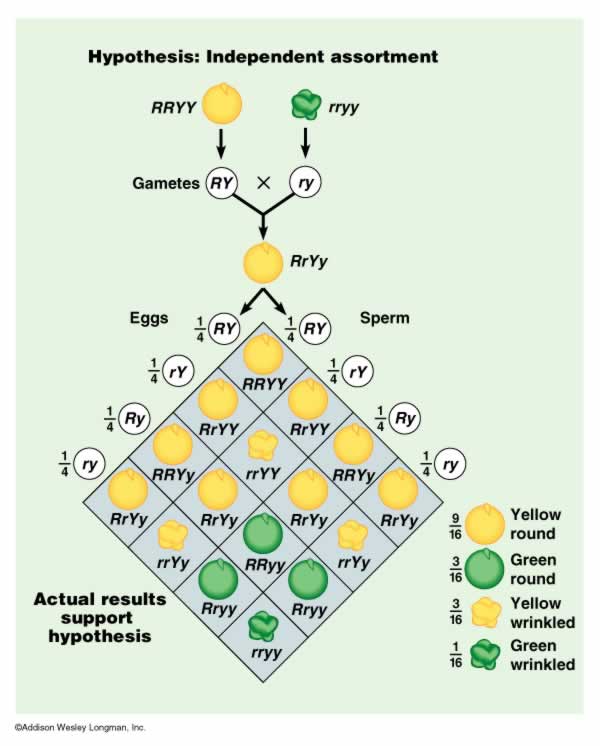 Round, Yellow (RRYY) x wrinkled, green (rryy)
Round, Yellow (RRYY) x wrinkled, green (rryy)
3. Dihybrid Experiments
Most animal and plant breeders had noticed that some traits seem to be inherited together. Indeed, in his own experiments, Mendel saw that flower color was always correlated with the color of the seed coat, such that seeds with white seed coats grew into plants with white flowers, and seed with brown seed coats grew into plants with purple flowers. Having demonstrated that his seven traits all exhibited the same pattern of inheritance, he now set out to determine whether these traits were inherited in a dependent or independent manner. This is a very insightful question. For example, he had already demonstrated that yellow pea color was dominant to green, that round pea shape was dominant to wrinkled, and that F1xF1 crosses for each trait produced a 3:1 ratio in the offspring. Well, maybe these traits are inherited in the same way because they are governed by the SAME heritable unit factor (gene)... and that's why they produce the same pattern. If yellow and round were caused by the same gene, then of course they would be inherited in the same way. Or, maybe they are governed by different unit factors that have a pattern of heredity that is related to one another... maybe they are governed by different factors that "travel" from parent to offspring together - yellow always traveling with round, for instance. This had important practical applications, too. A sheep farmer would profit from sheep that produce both good wool and good milk (for feta or roquefort cheese) from his sheep herd. But, maybe the trait of quality wool is inherited with the trait of poor milk production. In that case, they might not want to strongly select for great wool quality, as milk production would suffer. It might be best to maintain a variable population that produces good wool and adequate milk. Every organism expresses a combination of traits, so addressing how combinations of genes are inherited is a very important question.
a. Parental crosses of stocks breeding true for two traits
First, Mendel bred plants together and created stocks that bred true for two traits: seed color and seed shape. He created a stock of plants that produced yellow, round peas and a stock that produced green, wrinkled peas. He already knew the dominance patterns, and had already concluded that parents bore two 'unit factors' (genes) for each trait. So, he hypothesized that the genotypes of the plants in each pure-breeding stock would be RRYY (round, yellow) and rryy (wrinkled green). He placed pollen from the wrinkled, green stock on flowers of the yellow, round stock and observed the progeny.
 Round, Yellow (RRYY) x wrinkled, green (rryy)
Round, Yellow (RRYY) x wrinkled, green (rryy)
He hypothesized that the parental types would produce RY gametes and ry gametes, respectively. The combining of the genes in the offspring would make only RrYy genotypes, that should all express the phenotypic traits of yellow, round peas. This hypothesis was confirmed. However, this did not yet address the issue of independence; this pattern would also have occurred if color and shape were governed by one gene, or if the genes were inherited in a dependent manner. In short, the Y had to be inherited with an R, because that's all the RRYY parent had to give.
b. Crossing the F1's:
He crossed the F1 individuals, and found the following results:
- 315 round, yellow peas (~ 9/16)
- 101 wrinkled yellow peas (~3/16)
- 108 round green peas (~3/16)
- 32 wrinkled green peas (~1/16)
TOTAL - 556 peas
c. His interpretation and hypothesis:
First, it was obvious that the two traits were not caused by the same gene; all yellow peas were not ALSO round - he had produced some yellow wrinkled peas. So, different genes governed see color and seed shape, and so the genes for these traits could occur in differnt combinations.
Mendel realized that the 3:1 ratios were still preserved for each trait, when considered separately. For example, taken together, the ratio of yellow:green peas was 416:140 (2.97:1) and the ratio of round:wrinkled peas was 423:133 (3.18:1).
And also, Mendel realized that the
results of this experiment, and the results of subsequently self-crossing these
hybrids, were consistent with the probability of occurrence of independent events.
We know this as The Product Rule: "The probability that independent events
will occur together is the product of their independent frequencies."
These ratios in which the traits occurred in combination equaled the products of the independent frequencies:
3/4 W X 3/4 Y = 9/16 WY (round yellow)
1/4 w X 3/4 Y = 3/16 wY (wrinkled yellow)
3/4 W x 1/4 y = 3/16 Wy (round green)
1/4 w x 1/4 y = 1/16 wy (wrinkled green)
Mendel's hypothesis can be stated like this:
During gamete formation, the way one pair of genes (governing one trait) segregates is not affected by (is independent of) the pattern of segregation of other genes; subsequent fertilization is random. This is called Mendel's Second Principle: Principle of Independent Assortment.
He tested this hypothesis is subsequent experiments using three traits (seed color, seed shape, and seed coat color), and showed that the combination of traits expressed in the offspring were consistent with predicitons from their independent frequencies. For example, In a "trihybrid" F1 cross (a self-cross of an individual that is heterozygous for all three traits - YyRrCc), the fraction of peas that are yellow, round, and have a brown seed coat (caused by the dominant allele, "C") should be 3/4 x 3/4 x 3/4 = 27/64. His results confirmed his hypothesis.
4. Dihybrid test cross:
We can test for independence a bit more directly, through a dihybrid test cross. The principle of independent assortment is really predicting what the frequencies of different gamete types will be. So, consider an organism that is a double heterozygote (RrYy). The principle of independent assortment predicts that the segregation of the R genes (R and r) during gamete formation will be unrelated to (independent of) the pattern of segregation of the Y genes (Y and y) going into the same gametes.
With respect to the "R" gene, it has the Rr genotype and should produce R and r gametes at a ratio of 1/2 R to 1/2 r.
Likewise, with respect to the "Y" gene, the organism should produce Y and y gametes at a ratio of 1/2 Y to 1/2 y.
Now, every gamete must carry one (and only one) gene for each trait. So first of all, there can't be Rr or Yy gametes. And, under the hypothesis of independent assortment, the types and frequencies of the gene combinations that occur in the gametes can be predicted as the product of their independent frequencies. So, we would predict that this organism would produce 1/4 RY gametes (1/2 R x 1/2 Y), 1/4 Ry gametes (1/2 R x 1/2 y), 1/4 rY gametes (1/2 r x 1/2 Y), and 1/4 ry gametes (1/2 r x 1/2 y). These gametes are in the first column in the figure, below.
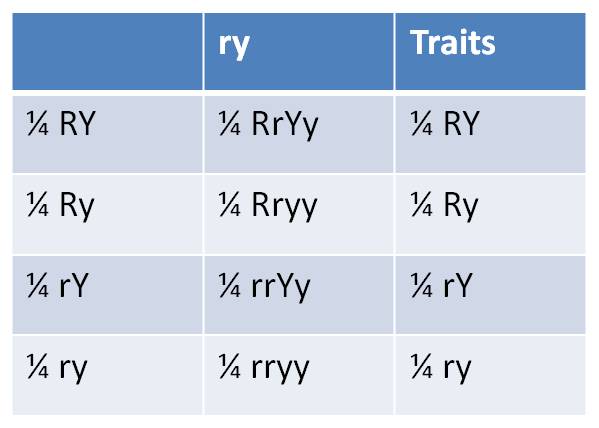 So,
to test independent assortment, we really want to know whether this organism
is producing gametes in these predicted frequencies. But we can't see the genes
in the gametes too easily; through heredity, all we can observe are the traits
in the phenotype of the offspring. And since these gametes carry recessive alleles,
it seems likely that they would be hidden from our observations.
So,
to test independent assortment, we really want to know whether this organism
is producing gametes in these predicted frequencies. But we can't see the genes
in the gametes too easily; through heredity, all we can observe are the traits
in the phenotype of the offspring. And since these gametes carry recessive alleles,
it seems likely that they would be hidden from our observations.
Unless we are clever.
If we mate this first organism to a second organism homozygous for the recessive traits (rryy), then the second parent will only donate recessive alleles (ry) to the offspring. (This gamete is in the header of the second column, at right). In this "test cross", the genes the offspring receives from the first parent will be expressed in the phenotype - we will be able to "see" the gene combinations, and their frequencies, produced in the gametes of the first individual. (The 'traits' expressed by the offspring - shown in the third column - are the same traits in the same frequencies as the gamete types produced by the first parent - shown in the first column.)
Mendel's quantitative approach and background in probability allowed him to conduct and interpret hybridization experiments in a new, more rigorous way. By examining and classifying the characteristics in offspring from particular parents, he was able to make insights into processes occuring at the cellular level. His two principles of heredity describe the allocation of genes to gametes - a process he never observed. However, 30 years later, cellular biologists confirmed that the hereditary units - called chromosomes - were allocated to gametes in a pattern consistent with Mendel's conclusions. It is worth reflecting on this for a second. All Mendel did was mate plants, collect and count seeds, and plant them. Yet, through his clever experimental design, he was able to test hypotheses and reach conclusions about phenomena that he could not observe directly. Human genius can be applied to any endeavor. In our modern technological society, we seem most impressed when genius is applied to making new technological innovations and devices. In science, however, genius can be expressed in the creativity of designing the correct experiment.
1. If the genes assort independently, then you can calculate ‘single gene’ outcomes and multiply results together…
For Example: AaBb x Aabb:
- what is the probability of an Aabb offspring?
- What is the probability of an offspring expressing Ab?
- How many genotypes are possible in the offspring?
- how many phenotypes are possible in the offspring?
Do the single-gene Punnett squares:
 and
and 
Answer each question for each gene, and then multiply the answers together:
- what is the probability of an Aabb
offspring? 1/2 (Aa) x 1/2 (bb) = 1/4
- What is the probability of an offspring expressing Ab? 3/4
(A) x 1/2 (b) = 3/8
- How many genotypes are possible in the offspring? 3
x 2 = 6
- how many phenotypes are possible in the offspring? 2
x 2 = 4
2. You can easily address more difficult multigene problems:
For Example: (female) AaBbCcdd x AABbccDD (male)
- how many types of gametes can each
parent produce?
- What is the probability of an offspring expressing ABCD?
- How many genotypes are possible in the offspring?
- how many phenotypes are possible in the offspring?
Answer the questions for each gene, then multiply the answers together:
- how many types of gametes can each parent produce?
| FEMALES - types of gametes at each gene (locus) | MALES - types of gametes at each gene (locus) |
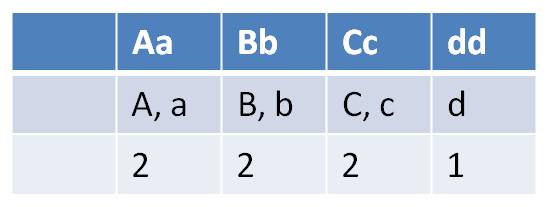 |
 |
| Females can make 2 x 2 x 2 x 1 = 8 gamete types | Males can make 1 x 2 x 1 x 1 = 2 gametes types |
With respect to offspring, do the single-gene Punnett squares:
 |
 |
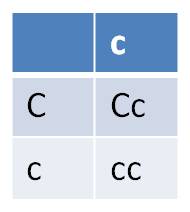 |
 |
- What is the probability of an offspring
expressing ABCD? = 1 (A) x 3/4 (B) x 1/2 (C) x
1 (D) = 3/8
- How many genotypes are possible in the offspring? =
3 x 3 x 2 x 1 = 18
- how many phenotypes are possible in the offspring? =
2 x 2 x 1 x 1 = 4
Note that for the C and D genes, we simplified the Punnett Squares. If a parent is homozygous for a gene, then it can only make one type of gamete with respect to that trait. So, to reduce redundancy, we just used one column for the 'cc' parent in the third Punnett Square, and only one row and one column for the parents in the last Punnett Square. The same could have been done for the AA parent in the first Punnett square - the information in the two columns is identical.
Meiosis produces specific types of reproductive cells. In animals, meiosis occurs in the gonads (ovaries/testes) and produces eggs or sperm. In plants and fungi, meiosis produces other reproductive cells called spores. The production of egg and sperm occurs for only one purpose - sexual reproduction. Sperm and egg must fuse (fertilization) before the development of the offspring can begin. Spores do not fuse; a spore is a single reproductive cell that simply begins to divide and grow on its own to become an offspring. In this lecture, we will ask the question "why sex?" Of course, in an evolutionary context, this question means "is this complex trait adaptive, and if so, how?" After describing the adaptive significance of asexual and sexual reproduction, we will describe the process, its relevance to Mendel's principles of heredity, and we will solve Darwin's dilemma regarding the source of heritable variation.
 A.
Overview
A.
OverviewWe have already considered the broader of issue of reproduction, itself. And we have examined one type of reproduction - mitosis. Although mitosis is the way that single eukaryotic cells divide, it is important to appreciate that, for single-celled eukaryotes (protists), this is a mechanism of organismal reproduction, as well. In addition, many organisms that are multicellular use mitosis as a form of organismal reproduction. For example, many plants grow lateral 'runners' along the ground or under the soil. From the end of this runner, a new bud can develop that grows roots and shoots. This bud can grow into an individual plant that is capable of living on its own, even after the runner is cut. All the cells in this new independent plant were produced by mitotic divisions from the parent plant. Indeed, this new plant is genetically identical to the original plant - it is a 'clone'. Fragmentation is another example of clonal reproduction in plants, where a branch that is broken or cut from a plant takes root and becomes in independent organism. This is more common for aquatic plants, where the broken fragment can stay alive and not dry out while it grows its own roots. Clonal reproduction also occurs in many animals. Corals and Hydroids (like the Hydra pictured at right) will grow a new polyp by mitotic division, and this polyp can 'bud off' the parent and become a new independent organism. In these cases, an offspring has been produced by a parent through mitosis, alone. The offspring is genetically identical to the parent. This clonal form of reproduction is also called "asexual reproduction".
Sexual reproduction represents the formation of a new genotype. This occurs in a number of ways in nature. In bacteria, genes can be donated from one cell to another, or even absorbed from the environment. This changes the genotype of the bacterium the receives these new genes. A new genotype has formed, even though there is no no organism produced. Many protists have multiple nuclei, and they exhibit a form of sex by exchanging micronuclei during conjugation. This also forms new genotypes without forming new organisms.
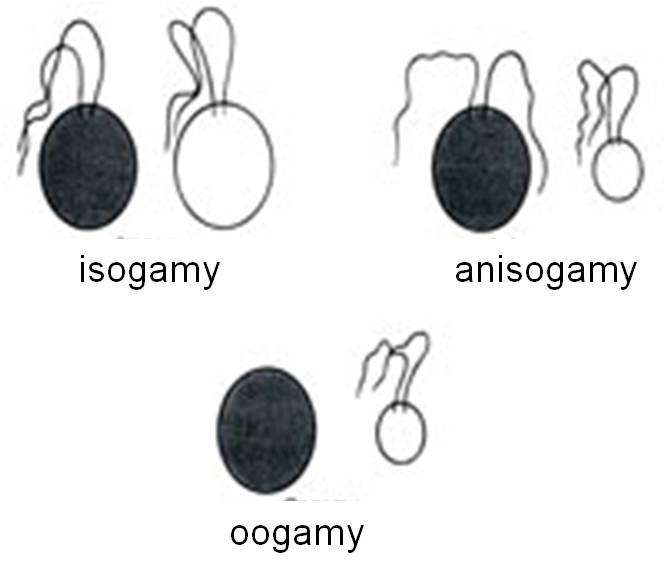 Typically,
however, sexual reproduction occurs through the fusion of specialized reproductive
cells called gametes. In some organisms (like fungi and some algae), the gametes
are all about the same size and are usually motile (with flagella). These species
are called isogamous (iso = equal). These species
don't really have 'males' or 'females'. Rather, individuals belong to 'mating
types' that produce genetically different types of gametes. Indeed, in most
of these species, there are many 'mating types' or 'sexes', defined by the capacity
of their gametes to fuse with other mating types (while not being able to fuse
with their own mating type). Isogamy is thought to be the ancestral form of
sexual reproduction. There are several theories that explain how a two sex (male/female)
mating system could have evolved from this multiple mating-type ancestor. The
first step was probably selection for one gamete to become larger while the
other became smaller, resulting in anisogamous species
with two distinctly different sized gametes that may still both have flagella.
From this stage, oogamy evolved, in which the larger
gamete became an unflagellated egg. In hermaphroditic
species (like many plants and invertebrate animals, and a few rare deep-sea
fish), single individuals produce both sperm and egg in different organs. In
plants, hermaphrodism describes plants with 'perfect' flowers, containing both
male and female organs. In some plant species, individuals have separate male
flowers and female flowers - these are monoecious
species. If a single organism can produce both sperm and egg, then it might
have the capacity to 'mate with itself'. These organisms are called 'self-fertile'.
Although mating with one's self makes searching for a mate rather easy, there
are some genetic downsides that we will consider in more detail later. So, many
of these species have evolved genetic mechanisms that prohibit an individual's
sperm from fertilizing its own eggs. These organisms are called 'self-incompatible'.
Even without a genetic incompatibility, many organisms reduce the changes of
self-fertilization by releasing their sperm and egg at different times.
Typically,
however, sexual reproduction occurs through the fusion of specialized reproductive
cells called gametes. In some organisms (like fungi and some algae), the gametes
are all about the same size and are usually motile (with flagella). These species
are called isogamous (iso = equal). These species
don't really have 'males' or 'females'. Rather, individuals belong to 'mating
types' that produce genetically different types of gametes. Indeed, in most
of these species, there are many 'mating types' or 'sexes', defined by the capacity
of their gametes to fuse with other mating types (while not being able to fuse
with their own mating type). Isogamy is thought to be the ancestral form of
sexual reproduction. There are several theories that explain how a two sex (male/female)
mating system could have evolved from this multiple mating-type ancestor. The
first step was probably selection for one gamete to become larger while the
other became smaller, resulting in anisogamous species
with two distinctly different sized gametes that may still both have flagella.
From this stage, oogamy evolved, in which the larger
gamete became an unflagellated egg. In hermaphroditic
species (like many plants and invertebrate animals, and a few rare deep-sea
fish), single individuals produce both sperm and egg in different organs. In
plants, hermaphrodism describes plants with 'perfect' flowers, containing both
male and female organs. In some plant species, individuals have separate male
flowers and female flowers - these are monoecious
species. If a single organism can produce both sperm and egg, then it might
have the capacity to 'mate with itself'. These organisms are called 'self-fertile'.
Although mating with one's self makes searching for a mate rather easy, there
are some genetic downsides that we will consider in more detail later. So, many
of these species have evolved genetic mechanisms that prohibit an individual's
sperm from fertilizing its own eggs. These organisms are called 'self-incompatible'.
Even without a genetic incompatibility, many organisms reduce the changes of
self-fertilization by releasing their sperm and egg at different times.
 In
dioecious (two 'houses') species, individuals are
either male or female. Males are defined as the sex that produces sperm, while
females are defined as the sex that produces the large egg. This is a more comprehensive
way to define a sex, allowing us to define sexes in species where the sexes
are morphologically indistinguishable. Many fish, for instance, lack genitalia
and simply excrete their gametes - egg or sperm - into the water for fertilization.
In some species, individuals change their sex as they develop and age. This
is called sequential dioecy or sequential
hermaphrodism. Organisms that are males first and then change
to females are called protandrous, while individuals
that are females first and then change to males are called progynous.
In
dioecious (two 'houses') species, individuals are
either male or female. Males are defined as the sex that produces sperm, while
females are defined as the sex that produces the large egg. This is a more comprehensive
way to define a sex, allowing us to define sexes in species where the sexes
are morphologically indistinguishable. Many fish, for instance, lack genitalia
and simply excrete their gametes - egg or sperm - into the water for fertilization.
In some species, individuals change their sex as they develop and age. This
is called sequential dioecy or sequential
hermaphrodism. Organisms that are males first and then change
to females are called protandrous, while individuals
that are females first and then change to males are called progynous.
As you can see from this introduction, sex can be alot more complicated than you might have thought. It can involve the production of new organisms, or only new genotypes. It can involve multiple sexes, or just two sexes. It can involve organisms that are one sex, two sexes, or change sex, and organisms that mate with themselves. However, even given all this variation, the common element in every case of sexual reproduction is the production of a new genotype. In asexual reproduction, the daughter cells are nearly identical to the parent cell (except for rare mutations). Next, we will compare the adaptive benefits of each type of reproduction. And remember, adaptations are traits that increase the reproductive success of a genotype in a given environment.
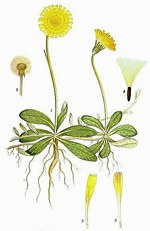 1.
The Costs and Benefits of Asexual Reproduction:
1.
The Costs and Benefits of Asexual Reproduction:
a. Benefits:
1) Probability of mating is high - you don't need to find a mate!
2) All else being equal, reproductive output and the transmission of genetic information to the next generation should be high. In fact, asexual reproduction maximizes the transfer of parental genes to the next generation: every offspring receives the entire genome of the parent. So, in terms of "differential reproductive success" (what's that? - you'd better know!!!), asexual reproduction has a quantitative edge in getting parental genes into the next generation.
3) In a constant environment, the offspring should all do well (they have the parent's genome, and the parent survived and reproduced in this environment with that genome). So, when the environment is stable, the probability of offspring survival and reproduction should be high. So, in a constant environment, clonal/asexual organisms should reproduce easily and quickly, and their offspring should thrive and reproduce.
b. Costs:
1) Mutations occur, and most are deleterious (have negative effect). From one generation to the next, these mutations will accumulate in a lineage because every parental gene is passed to the offspring. There is no way to "get rid" of bad genes or deleterious mutations.... this is called "Muller's Ratchet". Selection can weed out bad genes from a population, but over time all lineages will be burdened by the accumulation of deleterious genes.
2) Mutations become the only source of beneficial, adaptive variation. Because mutation rates are low, reproduction must be very rapid (prodigious, like bacteria), to create enough variation through mutation, alone, to by chance produce something new and useful.
3) Few environments on Earth are stable over the long term. When an environment changes, survival of offspring will be an "all or none" affair. If that genome can't survive in the new environment, then all the offspring die and that lineage comes to an end. Over time, we might expect every lineage in a species to encounter an environment to which it is not suited, resulting in the extinction of the species.
2. The Costs and Benefits of Sexual Reproduction:
a. Costs:
1) For organisms that cannot mate with themselves, sexual reproduction can be an energetically expensive behavior. There are energetic costs to finding and acquiring a mate.
2) Only 1/2 a parent's genes are passed to each offspring; so it is not as effective at transmitting parental genes to the next generation as asexual reproduction.
3) Many offspring will inherit combinations of genes poorly suited for the environment - or at least more poorly suited than the parental combination. In the luck of the draw, some offspring may receive most of the parents' 'bad' genes.
b. Benefits:
1) Since each offspring inherits only 1/2 the genes from each parent, deleterious genes can be purged from a lineage just be chance. In other words, just by chance, many of the offspring will have 'lucked-out' and will not inherit any of the new, deleterious mutations produced in the preceeding generations. This eliminates the effects of Muller's ratchet.
2) By combining genes from two parents, or by exchanging genes between organisms, new variation is produced MUCH more rapidly than by mutation, alone. Although many of these new genetic combinations may perform worse than the parents in a given environment, some may perform better. Better combinations will be able to harvest energy and convert it into offspring more effectively. In other words, "better" means better able to survive and reproduce in an environment.
3) When the environment changes (and it almost always will), it is more likely that, among the variable genomes produced by sexual reproduction, there will be a genome that can tolerate (if not excel) in this new environment. So, over the long term in changing environments, asexual lineages are likely to meet an environment they can't tolerate and go extinct, while sexual lineages are more likely to persist.
3. Summary:
Many organisms reproduce asexually. Indeed, for many organisms like bacteria, asexual reproduction is the primary mode of reproduction. Asexual reproduction is adaptive when environmental conditions are stable; it is a highly effective way for a genotype or lineage to 'out reproduce' other genotypes or lineages in the environment, and acquire limiting resources. However, because sexually reproducing species produce more variation per unit time, sexually reproducing species will adapt more rapidly to environmental conditions. In a changing environment, this means that sexually reproducing species can continue to adapt with the changes in the environment, while asexual lineages go extinct as they meet up with environments that they can't tolerate. The exception proves the rule here. If we look at organisms that reproduce asexually most of the time, we can ask "under what conditions do they switch to a sexual mode of reproduction?" The answer is usually: "when the environment changes." It is precisely under changing conditions that sexual reproduction is adaptive.
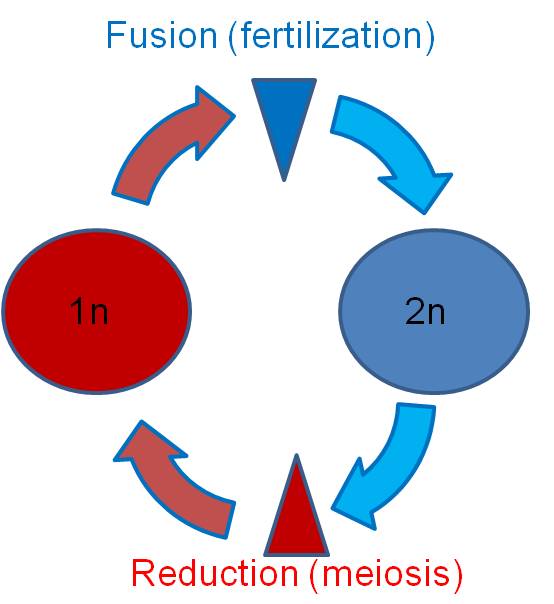 1.
How? - Reduction and Fertilization
1.
How? - Reduction and Fertilization
There is a big benefit to combining genes from different organisms - new variations are produced that may be adaptive. Some organisms donate genes between cells, others trade nuclei. But for most sexually reproducing organisms, this mixing of genomes occurs through the production of specialized cells called gametes that fuse to form a new genotype and a new organism.
There is a problem to fusing normal body cells to produce this variation. By fusing body cells, the number of chromosomes and the amount of genetic information doubles each generation. As we'll see, many of the chemical reactions and patterns of genetic regulation depend on a constant balance of enzymes and substrates, and a constant balance of particular proteins. Doubling the genetic information can disturb these quantitative relationships. In addition, fusing body cells does not escape the constraints of Muller's ratchet - all genes are passed to offspring and the offspring now acquire all the bad genes from BOTH parents.
The solution that life evolved is a new process of cell division - meiosis. In this process that produces specialized reproductive cells, the genetic information is halved. This halving is also called reduction. If the cells produced by this process are gametes (remembering that plants and fungi use meiosis to produce spores), then the fertilization of sperm and egg reconstitutes the appropriate set of genetic information for that species.
Study Questions:
1. Consider this cross: (male) AaBbCcDD x (female) AaBBccDD
- Assume independent assortment and dominance (capital is dominant to lower case) at each gene.
- How many types of gametes can each parent make with respect to these traits?
- How many genotypes and phenotypes are possible in the progeny?
- What fraction of offspring would you expect to express the ABCD phenotype?
2. Diagram a cell, 2n=4, as it goes through Meiosis.
3. Explain how recombination creates an extraordinary amount of variation.
4. Explain how the movement of chromosomes in Meiosis I provides a mechanistic description of how Mendel's two principles work.
5. What are the costs and benfits of sexual and asexual reproduction?
6. How can male and female sexes be allocated in plants?
7. Distinguish between zygotic, gametic, and sporic meiosis.